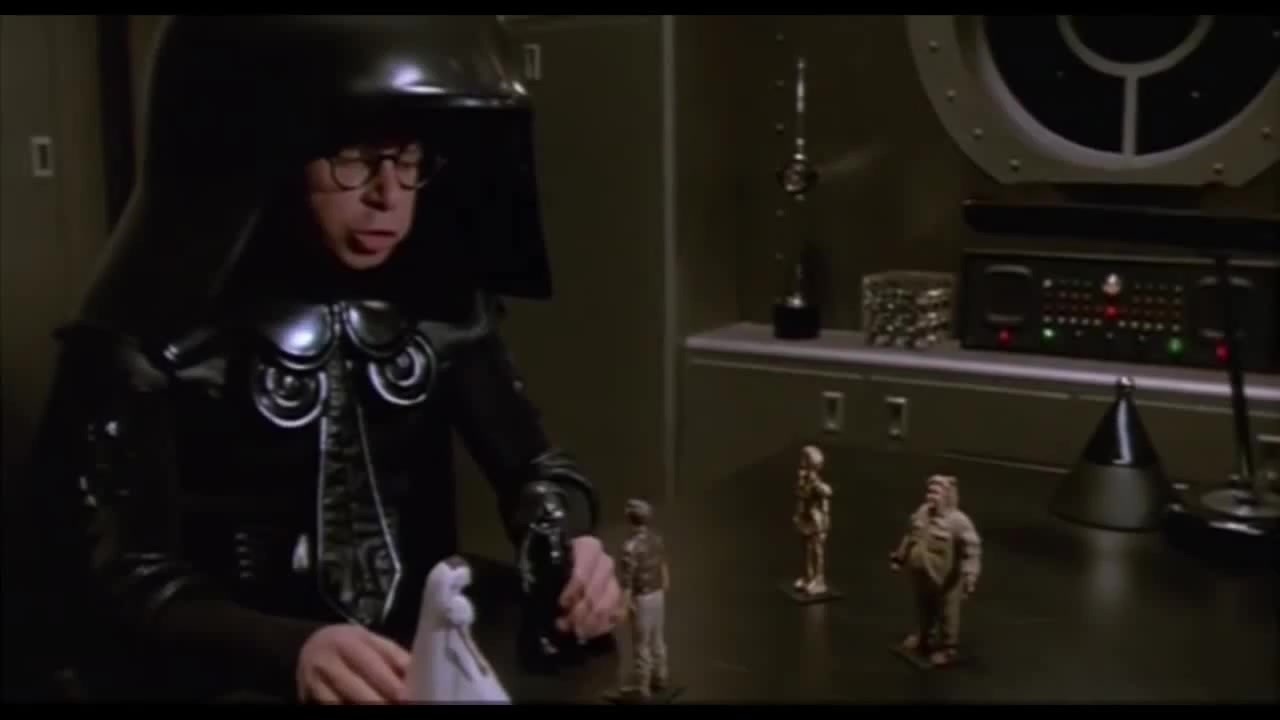There’s a reason George Lucas wouldn’t let people play with Mel Brooks’ Spaceballs toys, and it’s not what you think.
In the Star Wars universe, the empire always strikes back, but sometimes preemptively. Princess Vespa scooters, Lone Starr Pez dispensers, Barf air bags, and Prince Valium chewables are just a few things the retail market never got the chance to see because Mel Brooks’ Spaceballs merchandise never got off the launchpad.
“Merchandising is where the real money from the movie is made,” the learned Yogurt explains in the 1987 science fiction comedy. “Spaceballs the T-shirt! Spaceballs the coloring book! Spaceballs the lunchbox! Spaceballs the breakfast cereal! Spaceballs the flame-thrower! (The kids really love that one.)”
Brooks may be a comic genius, but he missed out on the most lucrative aspect of filmmaking: the toys. Sure, he proved how to make more money from a flop than a hit in his film and play and film The Producers, but he didn’t raffle a single seat from The Twelve Chairs, and he bought them retail, but wouldn’t break up the set. Of all the genres Brooks has lampooned – horror, westerns, psychological thrillers – none produce more mockable and marketable nick-nacks than space opera. The idea to breach and pastiche new frontiers came to Brooks at his then-10-year-old son Max’s Star Wars–themed birthday party.
“I thought, science fiction,” Brooks writes in his book All About Me! My Remarkable Life In Show Business, via Literary Hub. “Now there’s a genre I haven’t wrecked yet.”
The idea opened possibilities to skewer such beloved galactic debris as “Star Trek, Battlestar Galactica, and, reaching back for more fun, the unique and campy director Ed Wood’s Plan 9 from Outer Space. It was a genre rich with opportunities for devastating satire.”
The genre is also rich in the vast wealth of toys, gadgets, and collectibles. Rick Moranis, who parodied Star Wars’ villain Darth Vader in the role of Dark Helmet, “brilliantly improvised one of his most famous scenes in the movie, the one in which he gets caught playing with little action figure versions of Lone Starr, Princess Vespa, and himself,” Brooks said.
As perfect as this looks on screen, it never materialized on the loading docks for store shelves. “Even though in the movie itself we have Dark Helmet playing with action figures, we never sold any,” Brooks said.
In spite of the recurring gag which runs through Spaceballs, no actual merchandise was ever marketed. The movie was made for it, and the concept made it into the film, but no collectibles were ever used to promote the movie, sold at shops, or hawked at conventions. The decision came from on high.
“The same way I called Alfred Hitchcock to get his blessings on High Anxiety, I sent the Spaceballs script to Star Wars creator George Lucas,” Brooks wrote. “He said he had seen Blazing Saddles and Young Frankenstein and was a big fan. He enjoyed the script, and only had one real caveat for me: no action figures.”
Under First Amendment law, parody has greater license to borrow material when it comes to copyright infringement cases, but proprietary rights carry their own precedents. Brooks envisioned Spaceballs as an intergalactic version of Frank Capra’s 1934 classic It Happened One Night. He recognized Star Wars for its similar historical cinematic impact. As art, they were ripe for picking. As commerce, they had thorns because they needed protection, and Brooks took Lucas’ counsel respectfully.
“He explained that if I made toys of my Spaceballs characters they would look a lot like Star Wars action figures,” Brooks said. “And that would be a no-no for his lawyers and his studio’s business affairs department. So, he gave his blessing to make my funny satiric takeoff of Star Wars as long as I promised that we would not sell any action figures.”
Because he was in on the joke, Lucas signed a fair use agreement allowing Brooks to spoof Star Wars characters, as long as Brooks agreed he wouldn’t compete in the merchandising marketplace.
“And that was one of the rules we didn’t break,” Brooks writes.
This implies the comedy director who co-created Get Smart with Buck Henry could break as many other rules as that show’s insidious KAOS espionage agency. The exchange with Lucas didn’t only instigate a series of self-referential jokes to the legal caveat itself in the film, it inspired larger comment on the inherent cynicism of the motion picture practice.
While Brooks followed the standards of satiric practices, he freely toyed with the quantum physics of product placement. While he couldn’t lease a factory in the toasted-oats mecca of Battle Creek, MI., to box up “Spaceballs: The Breakfast Cereal,” he gleefully covered Dom DeLuise in “bubbling cheese and studded with slices of pepperoni” to better deliver his role as Pizza the Hut, and in 30 minutes or less.
Merchandise or not, Spaceballs is a tremendously effective send-up of a perennial favorite, which has in some ways come to overshadow its subject matter.
“I’ve even gotten some letters from young fans that saw Spaceballs before they saw Star Wars,” Brooks wrote. “They would often ask me why Star Wars wasn’t so funny.” This alone justifies a “Spaceballs: The Breakfast Cereal” box-top collectible surprise like a Schwartz-powered ring Cracker Jacks prize.
